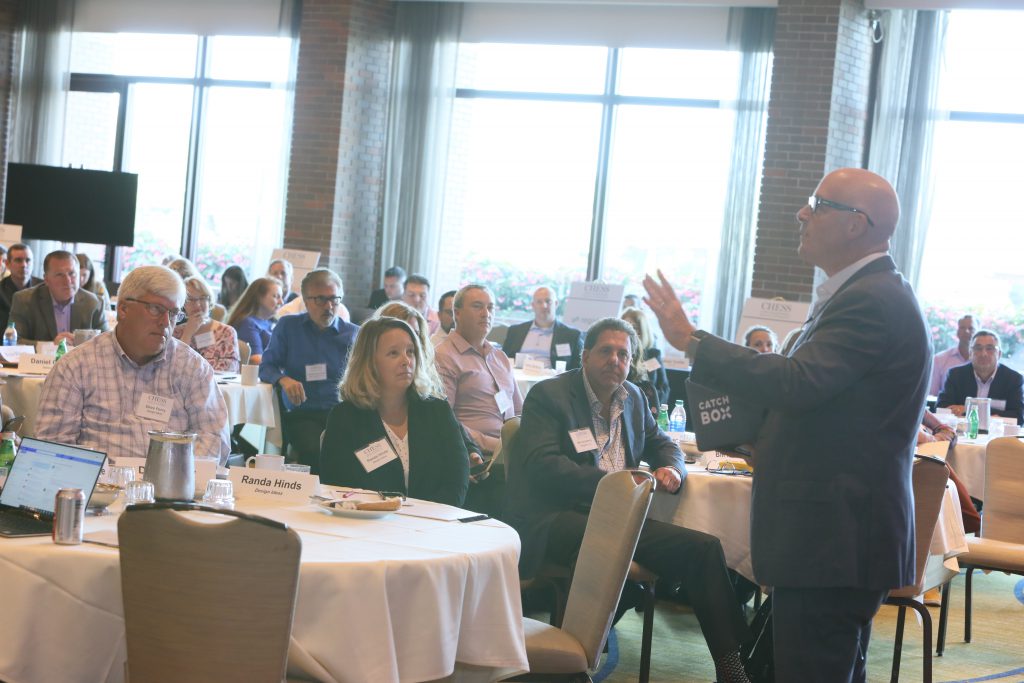Former stockbroker Mark Jeffries is a popular keynote speaker and moderator/MC for events in the U.S., Canada and Europe. Jeffries has spoken before many business conferences, published two books, is a frequent guest on NBC Today, BBC News and writes for the Huffington Post. He recently launched his innovative e-learning course, “The Art of Business Influence – Selling without Selling.”
Jeffries opened by complimenting the Housewares Hot Seat panelists, as their conversation on communicating with young job candidates was a fine introduction to what he would share with the audience. He discussed the art of communication to reveal how we influence, not manipulate, people to come around to our way of thinking. His session was memorable not only for his animated and humorous delivery, but for how smoothly he regained his pace after a fire drill interrupted the presentation.
Trained as an economist, Jeffries left his job as a London stockbroker to host TV talk shows about business. Interviewing executives made him think about how some charismatic people were very persuasive and others couldn’t keep a listener’s attention. In business, we are all trying to promote our products or convince someone of our point of view.

Selling Yourself and Your Story
“When somebody asks you what do you do, how do you frame yourself?” Jeffries asked. Stepping into the audience, he asked several people to introduce themselves, then named each answer a “P” or a “VB.” He explained “P stands for Process. It’s your title on your business card and your LinkedIn profile. That’s the work you do. VB stands for Value and Benefit. When someone hears what you do, they are trying to translate that into What can you do for me? —that’s what the person needs to hear from you. You will answer differently when you talk to a potential employee or to a friend.”
He outlined that each individual has three new jobs; these are new table stakes for business communication and the methods should be top of mind for business leaders.
- Head of Sales. We are all in sales. We define ourselves by our dress, our behavior, how we speak. People meet us and think “Do I buy this person or not?”
- Director of Translation: We must learn to speak the language of our listeners. Give some background on a topic you mention. When you are an expert, you have thecurse of knowledge. Make sure that you remain clear and understandable. Translate acronyms as you go. Bring others along in your story or you will lose them.
- Chief Story Teller. Tell the stories of your business. People remember stories, not pie charts. Use examples to show relevance to the listener’s needs and interests. People repeat stories and those go viral.
What is Your Red Pencil?
As you tell your story to a potential client, for example, you must differentiate yourself. Everyone wants to know what’s new. Explain how your product will work for the client. A product demonstration or a souvenir make an impression and show how your product differs from the competition. A tiny differentiator can have a huge impact at any point in the communication.
Jeffries then walked the audience through the LWAR steps to successful communication. Forgetting to do first three steps and then picking up the phone or sending a hasty email filled with typos could mean trouble ahead!
The LWAR Route to Communication Excellence
L – Listen
W – Watch
A – Anticipate
R – Respond/React
Listen—We all think we are good listeners, but how many of us have “name amnesia” when we meet a new person? We are so eager to tell our own name and our story that we forget to listen. Take that moment of introduction to be an active listener. Listen with the intent to understand instead of the intent to reply. Start to listen for what is not said and that will reshape the data you hear.
Watch—Every interaction screams data and we need to understand how to interpret it. Jeffries spoke of athletes who watch films of their own performance. By watching themselves to learn from their mistakes, they miss what they were reacting to. Instead, by focusing on the opponent, an athlete can spot the other player’s “tell” or visible clue of his next move. That’s the power of watching changing dynamics.
In a business setting, notice how people sit. A senior person who leans back in his chair and crosses his arms signals that he has nothing to learn and is the one in charge. But when you are presenting a great idea or product, sit at the edge of the chair and lean toward the listeners to gain the trust of your audience.

Anticipate—Anticipate the needs of the people in front of you. Put yourself in their shoes. What do they want? Every person is different. You need to figure out what they need to hear. We are a tribal people; we like to hang out with people like us. We want to develop a kinship based on interests and hear about how we all face the same challenges and opportunities. Find a connection, a NBB–Non-Business Bond. Runners know that when they are out in the freezing cold and see another runner approaching, they nod to greet the other as they pass. That’s the Non-Business Bond. Dog people are more likely to do business with dog people. Find your tribal connection, and that anticipation phase will go smoother and allow you to better understand the data.
Respond—Once you have done all the previous steps, offer your solutions.
BRAINS of Influence
This acronym explains how to influence others to come around to your way of thinking.
Bridging—Bridging is about the socially minded, connected person. This is based upon social proof, or the jealousy effect. If others are doing it, I need to do it too. It starts in childhood. Think of children playing with toys–one child will want what another child has. Use this in business to tell stories of how others are already benefitting from what they have bought from you. The socially minded Bridger will come to his own conclusion. That’s how Amazon and Facebook operate. People tell others what they are doing and buying.
Rationalizing—A rationalizing person is the opposite of the Bridger. Rationalizers are the “black and white, 1+1=2” thinker. They have no patience for fluff or fat, they want you to solve their problems. They are not influenced by stories. But your job stays the same. You need to know if a Bridger or a Rationalizer is sitting in front of you and what they respond to.

Asserting—Assertive or aggressive, the crucial difference is in timing. Sometimes people need to be guided, other times they need a push. Urge them to act now to prevent a problem in the future that you have foreseen. Often people are more impacted by a potential loss than a potential gain. The negative side has more power if it is in our best interest.
Inspiring—Inspiration is for the creatives in your world. Such people can’t be bothered by process, they want to know the outcome. What does this mean for me? They might wonder, “if there is so much work to be done, why are we doing it?” because of what will happen at the end. Some people have no interest in the journey, just the destination. If you are selling a drill, the destination is the hole in the wall. Gyms and vacation cruises sell the destination, not the journey of what it takes to get to that result.
Negotiating—You have figured out what drives the people you are talking with and you plan to offer something before it is asked for. This is pre-negotiating. If you can promise to deliver in advance or be finished a month before deadline, you make the transaction easier and prove in an instant how much you care. By guessing what they will ask for, you show you know their world.
Specializing—Jeffries said everyone in the audience was a specialist who presumably knows more than others in their field. People want to trust a specialist. Communicate constantly that you have seen it and done it so you can be trusted. It’s not about bragging but should be part of your general communication. Trust influences the outcome.

Be the Closer
Consistency, clarity and confidence are the qualities of top leaders and communicators. Have a solid, consistent plan. In case of obstacles, explain the change in direction will not change the destination. The great test of clarity is that after a meeting, the people in the meeting should be able to repeat your message in their own words. The BRAINS of influence also apply in the online world, whether Instagram, LinkedIn or YouTube. Additionally, video has become important; recent research shows that 90% of consumers claim a video will help them decide on a purchase. If your company is not present in video, your impact will not be as strong. It’s a basic business tool now.
Be animated when you speak—train your voice to be engaging. If you are passionate in your story, people listening will share your passion. Your voice is another tool of influence.
We are all in sales, translating our world to invite others to join us. We anticipate before we react, bridge, rationalize, inspire and pre-negotiate. We confidently show that we are experts and are passionate about our cause. By using the tips Jeffries shared at CHESS, the scales of influence will tilt in our favor.
To learn more about Mark Jeffries, see www.markjeffries.com



